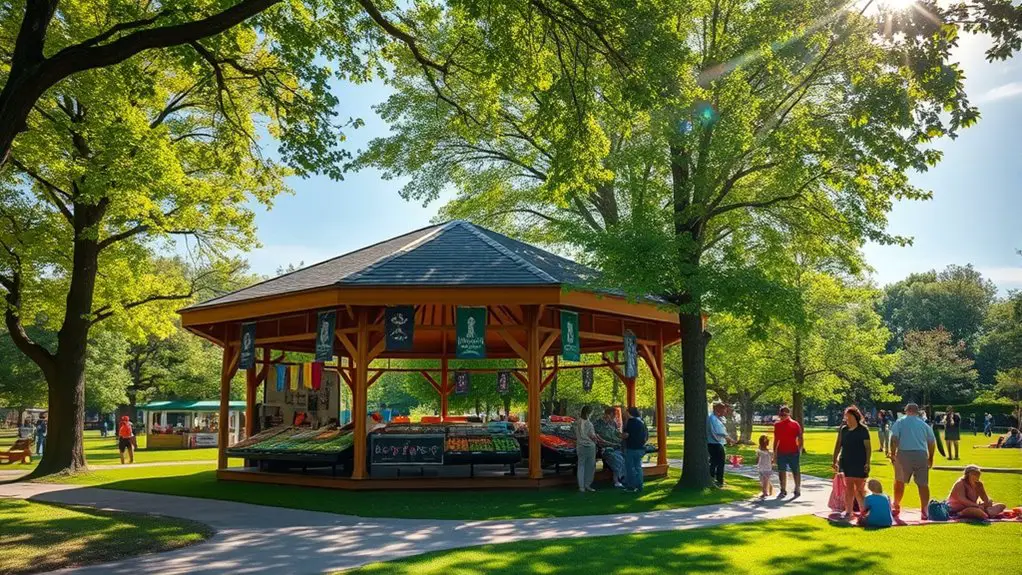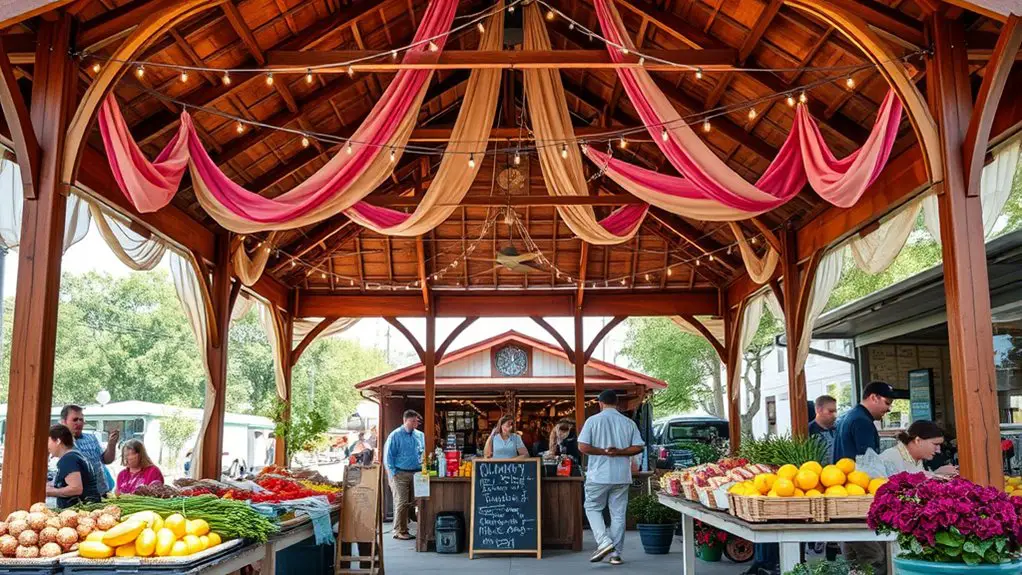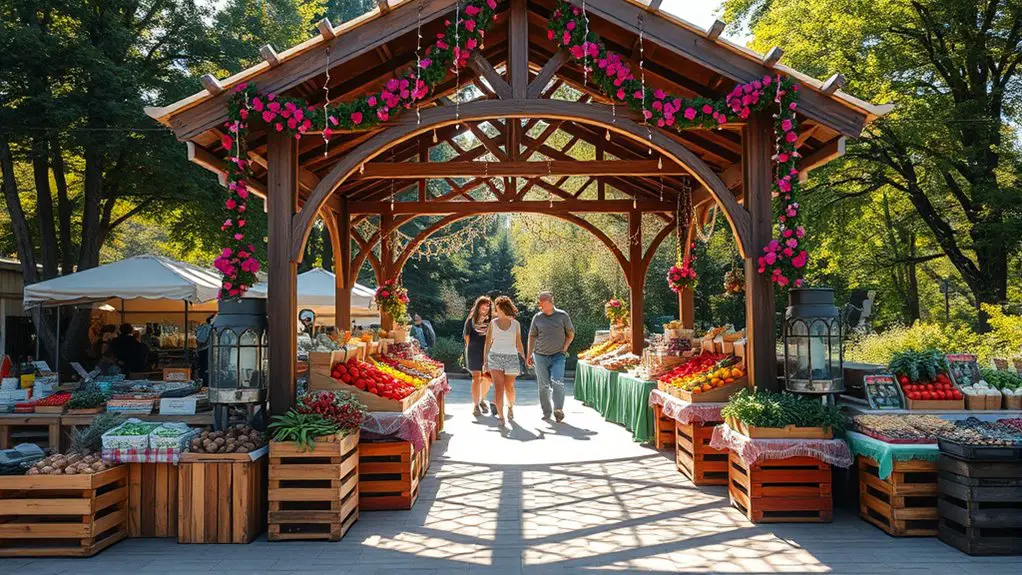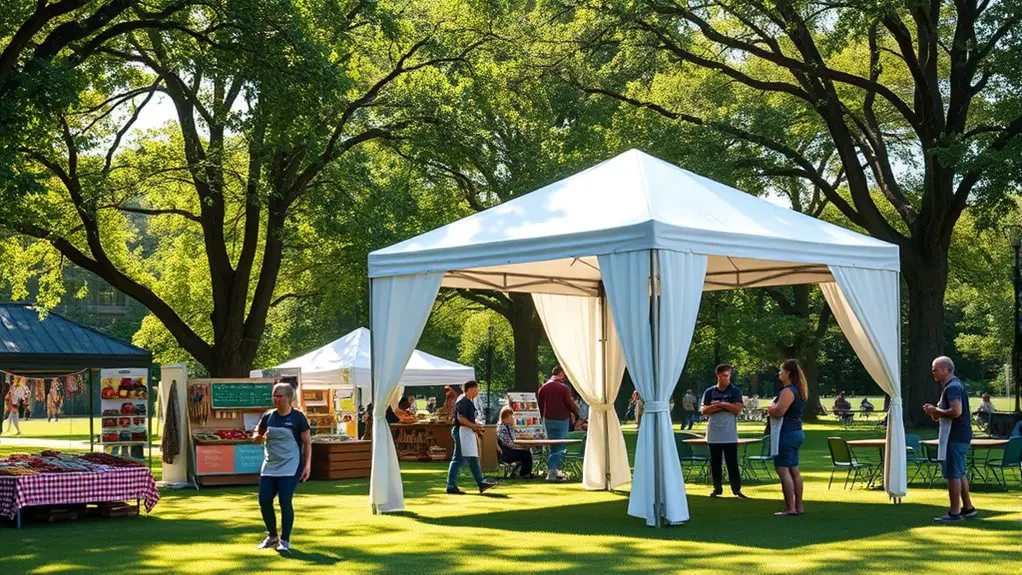To set up a gazebo for your community farmers’ market, first choose a high-traffic location while guaranteeing it complies with zoning regulations. Focus on stability by using anchoring kits and weights, and guarantee accessibility for visitors. Design an inviting layout with clear pathways and seating areas, and incorporate functional features such as lighting and shelter from weather. Enhance aesthetics with colorful decor and natural elements. Doing this can create a vibrant atmosphere that draws in guests. There’s more to discover!
Selecting the Ideal Location for Your Gazebo

When you’re selecting the ideal location for your gazebo at a farmers’ market, it’s important to take into account factors that can enhance visibility and accessibility. Start by checking zoning regulations to confirm that your chosen spot complies with local laws. Avoid any areas where restrictions might hinder your setup.
Next, consider foot traffic. Position your gazebo where people naturally gather; near entrances, food stalls, or popular vendors can boost your visibility considerably. You want the bustling energy of the market to work in your favor, drawing customers toward your offerings.
Also, think about the layout of your space. Don’t block pathways or create obstacles that might deter potential customers. Keeping these elements in mind will not only help you attract more visitors but also create an inviting atmosphere that encourages people to explore what you have to offer. Additionally, ensure that the gazebo placement offers adequate space around it to avoid overcrowding and enhance overall accessibility.
Ensuring Stability and Safety
To guarantee your gazebo is stable and safe, you’ll need to focus on grounding techniques and weight distribution. Consider how weather conditions can impact your setup, as strong winds or rain could pose risks. By addressing these factors, you can create a secure environment for both your gazebo and the visitors at the farmers’ market. Additionally, implementing anchoring kits for effective ground attachment will enhance the stability of your gazebo against unpredictable weather.
Ground Anchoring Techniques
While setting up your gazebo at a farmers’ market, ensuring its stability and safety is essential, especially in windy conditions. Start by using ground stakes to secure the gazebo to the ground. Drive them into the soil at a 45-degree angle, which provides maximum hold against gusts. If the ground’s too hard, consider using sandbags for added weight. Place them at each leg of the gazebo, distributing the weight evenly to prevent tipping. These bags can be filled with sand or gravel, offering a solid anchor. Remember, your goal is to create a safe space for both you and your customers, allowing everyone to enjoy the market atmosphere without worry. So, take the time to secure your gazebo properly!
Weight Distribution Strategies
Although securing your gazebo is essential, understanding weight distribution strategies can greatly enhance its stability and safety. Start by implementing effective weight distribution methods, which focus on placing heavier items closer to the base. This ideal load placement helps lower the center of gravity, reducing the risk of tipping. Utilize sandbags or weights at the corners, ensuring even distribution across all sides. If you’re using tables and displays, arrange them with heavier products at the back and lighter ones at the front to maintain balance. Regularly check your setup, especially during busy market hours, as shifting items can affect stability. By prioritizing weight distribution, you’ll create a safer environment for vendors and customers alike, allowing everyone to enjoy the market experience.
Weather Considerations
When planning your gazebo setup for a farmers’ market, it’s essential to take into account the weather conditions you might face. Implementing effective sun protection strategies and rain contingency plans will guarantee your setup remains stable and safe.
Here’s a quick overview of considerations:
| Weather Condition | Sun Protection Strategies | Rain Contingency Plans |
|---|---|---|
| Sunny | Use UV-blocking fabric | Have waterproof tarps ready |
| Rainy | Position gazebo strategically | Provide drainage options |
| Windy | Secure with heavy weights | Have an evacuation plan |
| Overcast | Confirm adequate lighting | Monitor for possible rain |
Designing an Inviting Layout
How can you create an inviting layout for your farmers’ market gazebo? A well-designed space encourages community interaction and enhances vendor flow, making everyone feel welcome. Here are three key elements to take into account:
- Zoning for Interactive Spaces: Create areas where people can linger and engage. Think about seating, shade, or even small activity corners to foster connections.
- Clear Pathways: Ascertain there’s a logical flow for both vendors and visitors. Avoid clutter and create wide walkways to make navigation easy. This keeps the market lively and accessible.
- Vendor Placement: Strategically arrange vendors to promote interaction. Mix food stalls with crafts or produce, encouraging customers to explore and discover new products. Additionally, consider surrounding landscape to enhance the aesthetic appeal and integrate the gazebo into the market environment.
Adding Functional Features

When setting up your gazebo for a farmers’ market, adding functional features is key to enhancing both customer experience and vendor efficiency. You’ll want to contemplate essential equipment and supplies, as well as layout and design tips that promote accessibility and safety. By addressing these aspects, you can create a welcoming and effective space for everyone involved. Additionally, consider installing mosquito netting to provide a comfortable environment free from pests, ensuring a pleasant shopping experience for customers.
Essential Equipment and Supplies
Setting up a gazebo for a farmers’ market requires careful thought of essential equipment and supplies to enhance functionality. To create an inviting and efficient space, you’ll need to gather some essential tools and necessary materials. Here are three key items to take into account:
- Tables and Chairs: Confirm you have enough seating and display space for vendors and customers.
- Canopy Weights: These are vital for securing the gazebo against wind, providing stability throughout the event.
- Lighting: If your market runs into the evening, adequate lighting can enhance visibility and create a welcoming atmosphere.
Layout and Design Tips
Creating an effective layout for your gazebo can greatly enhance the overall experience at the farmers’ market. Focus on layout optimization by ensuring proper vendor spacing to encourage foot traffic and interaction. Here’s a simple table to visualize your layout:
| Area | Purpose |
|---|---|
| Entrance | Welcoming shoppers |
| Vendor A | Fresh produce display |
| Vendor B | Artisan goods showcase |
| Communal seating area | Social interaction space |
| Exit | Smooth flow of traffic |
Accessibility and Safety Measures
An effective layout not only attracts customers but also guarantees that your gazebo is accessible and safe for everyone. To guarantee a welcoming environment, focus on the following features:
- Wheelchair Access: Make sure pathways leading to your gazebo are smooth and wide enough for easy navigation.
- Emergency Procedures: Clearly display emergency exits and have a plan in place for quick evacuations if needed.
- Safety Signage: Install signs to guide visitors and highlight any potential hazards, such as uneven ground.
Enhancing Aesthetics With Decor

A vibrant display can truly elevate the atmosphere of your farmers’ market gazebo. To enhance aesthetics, consider incorporating decorative elements that reflect the spirit of your community and the products available. Bright banners, colorful tablecloths, and seasonal flowers can create a welcoming vibe.
Visual branding is essential, so use cohesive colors and designs that resonate with your market’s identity. If your market has a logo, display it prominently on signage and materials. This not only beautifies the space but also fosters recognition among visitors.
Don’t forget about lighting! String lights or lanterns can add warmth and charm, especially as the sun sets. Finally, consider adding seating areas adorned with cushions or artwork, encouraging guests to linger and enjoy their surroundings. By focusing on these details, you’ll create an inviting environment that draws in customers and makes your farmers’ market a cherished community destination. Additionally, incorporating low-maintenance plants can enhance the natural beauty of the space and provide a relaxing atmosphere.
Collaborating With Vendors for Success
While enhancing your gazebo’s aesthetics can attract visitors, the success of your farmers’ market relies heavily on collaboration with your vendors. Strong vendor communication is key to fostering a supportive market environment. Here are three ways to work together effectively:
Collaboration with vendors is essential for a thriving farmers’ market, ensuring clear communication and shared goals.
- Set Clear Expectations: Discuss roles, responsibilities, and goals with each vendor. This guarantees everyone knows what’s expected.
- Implement Pricing Strategies: Collaborate on pricing to make certain products remain affordable yet profitable. Consider offering discounts for bulk purchases or loyalty programs.
- Encourage Feedback: Create an open line for vendors to share their thoughts. This helps you improve the market experience and keeps vendors engaged.
Frequently Asked Questions
What Permits Are Needed to Set up a Community Gazebo?
To set up a community gazebo, you’ll need to check zoning regulations and obtain health permits. It’s essential to guarantee compliance with local laws to avoid any issues that could hinder your project’s success.
How Can We Promote Our Farmers’ Market Effectively?
Imagine a garden thriving with diverse plants. To promote your farmers’ market, leverage social media and forge community partnerships. Share vibrant stories and fresh produce tips, cultivating connections that nurture local interest and participation.
What Weather Considerations Should We Keep in Mind?
When planning outdoor events, you’ve gotta consider rain protection and wind stability. Make certain your setup can withstand unexpected showers and strong gusts, allowing everyone to enjoy the market comfortably, regardless of weather conditions.
How Do We Handle Vendor Fees and Payments?
To handle vendor fees and payments, you’ll want clear fee structure guidelines. Offer various vendor payment options, like online systems or checks, ensuring transparency and flexibility, so vendors feel empowered and confident in their transactions.
What Are the Best Days and Times for a Farmers’ Market?
To maximize peak attendance, consider weekends, especially Saturday mornings. Seasonal trends show more visitors in spring and summer. Align your market’s schedule with local events for added exposure, ensuring a vibrant community atmosphere.


I think other web-site proprietors should take this site as an model, very clean and excellent user friendly style and design, as well as the content. You are an expert in this topic!